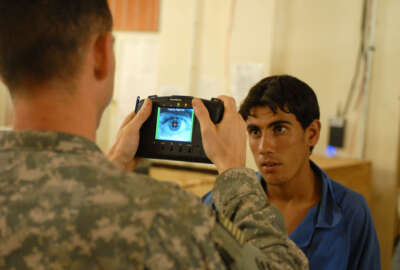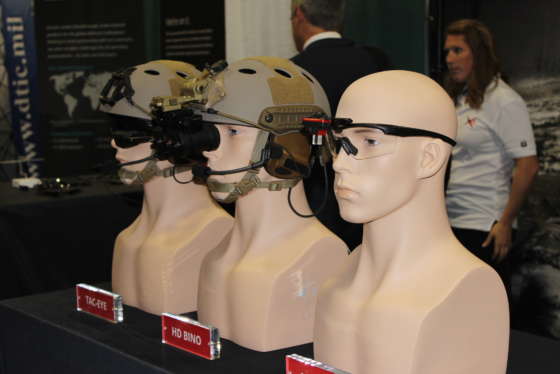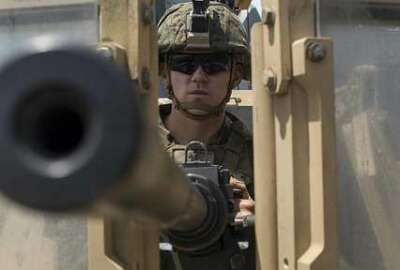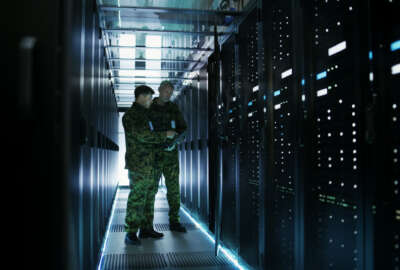
State-of-the-art tech makes debut at Army S&T conference
The Army S&T conference showcased new technologies to help soldiers' performance on and off the battlefield.
Best listening experience is on Chrome, Firefox or Safari. Subscribe to Federal Drive’s daily audio interviews on Apple Podcasts or PodcastOne.
How many G-forces can an injured service member handle while hitching a ride on a drone? Does a small degree of difference in eye movement indicate a traumatic brain injury? How can doctors help wounded soldiers from thousands of miles away?
Those are all questions the Army is hoping to answer with some of its investments. The Army and industry showed off some of the most cutting edge technology the service is using or trying to use in the near future at the National Defense Industrial Association Army Science and Technology Conference this week in Washington.
While the Army has always been interested in emerging technologies, its interest was recently renewed by Defense Secretary Jim Mattis’ call for the military to stay ahead of near peer adversaries and increase its lethality.
Mattis told Congress in early May that the military needed to “restore its competitive edge in an era of re-emerging long-term great power competition” and with that comes big investments in technology.
“From a concept side we see a future where we will be contested in every single domain, so that’s why we are going after the concept of multi-domain operations. The technology we are developing and the priorities we are going after are all aligned against making our Army the strongest Army so we can preserve the peace in great power competition,” Army Vice Chief of Staff Gen. James McConville said during an Aug. 13 roundtable with reporters at the Pentagon.
The NDIA conference was an area where the Army laboratories, contractors working with the service and academia could show off some of the technologies the Army will need for that rivalry.
One technology already in partial use is wearable optics for soldiers. Six 15 Technologies is working with the Army to give soldiers visual displays in the form of headgear that allows them to see virtual reality or live camera feeds.
“These displays are primarily used as intelligence, reconnaissance and surveillance displays, which means watching video come down from an unmanned aerial vehicle to increase the situational awareness of the ground soldier,” said Matthew Voss, director of product line management at Six 15 Technologies.
Those optics are already in use by some special operations soldiers.
“The newer augmented reality displays leverage see-through optics and can provide real world contextual data. You can know where your targets are, your friendly forces are, where the hostile forces are. They’ve all been pre-mapped and those can be overlaid in your real world view,” Voss said.
But, not all of the emerging technologies are for use in fighting enemies.
Latest Army News
A recent study from the Center for a New American Security found shoulder mounted heavy weapons may be causing head trauma to troops during training.
The Army is teaming up with Neuro Kinetics to try headgear that can help diagnose traumatic brain injuries.
“You might recall in a movie where the doctor says follow my finger, where he tracks how well your eyes follow that finger. We are doing things like that. We are showing you a very simple dot and the cameras inside the goggle are watching how well your eyes follow that dot and then software is comparing the dot to your eye movements,” said Susan Zelicoff, vice president of sales and marketing for Neuro Kinetics.
The ability to track miniscule eye movements in fractions of a second can help doctors diagnose and come up with a treatment plan for injuries.
Other technologies at the conference included integrated domains. James Beach, research and development program manager at the U.S. Army Telemedicine and Advanced Technology Research Center’s Medical Intelligent Systems Lab, said the Army is working on ways to delivery medical care to soldiers in remote areas.
“We are looking at how we can support a medic who can’t evacuate a patient and he has a certain level of training, but he may be faced with a patient that is beyond his skill set,” Beach said. “The devices [we are working on] span from near-term emergent capabilities where we are looking to provide a telemedicine capability that would essentially allow the medic to phone a friend, a doctor.”
Beach said as he looks to the future the Army is trying to find ways to develop artificial intelligence to guide medics through procedures in case communications are degraded.
Beach’s team is also studying the use of drones to pick up wounded soldiers in remote and hard to reach areas and bring them home.
Drones “are not designed around the human so the constraints with the G-forces are not taken into account,” Beach said. His team is collecting data to determine safe ride standards and put restraints on the drones.
Copyright © 2025 Federal News Network. All rights reserved. This website is not intended for users located within the European Economic Area.
Scott Maucione is a defense reporter for Federal News Network and reports on human capital, workforce and the Defense Department at-large.
Follow @smaucioneWFED







